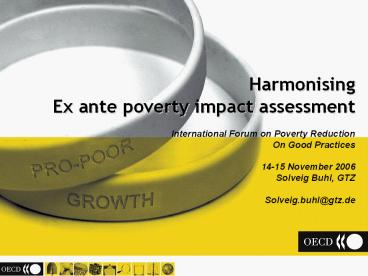Harmonising - PowerPoint PPT Presentation
Title:
Harmonising
Description:
Solveig Buhl, GTZ. Solveig.buhl_at_gtz.de ... The Task Team within DAC POVNET. Group founded in 2005 to develop harmonised and easy to use approach to (ex ante) ... – PowerPoint PPT presentation
Number of Views:27
Avg rating:3.0/5.0
Title: Harmonising
1
Harmonising Ex ante poverty impact
assessment International Forum on Poverty
Reduction On Good Practices 14-15 November
2006 Solveig Buhl, GTZ Solveig.buhl_at_gtz.de
2
A harmonised ex ante Poverty Impact Assessment
(PIA) is required
- The new challenges are
- Harmonization
- Alignment
- Accountability
- Management for Development Results
- Increasing effectiveness
3
The Task Team within DAC POVNET
- Group founded in 2005 to develop harmonised and
easy to use approach to (ex ante) poverty impact
assessment - Participants DAC/OECD, France, Germany, Japan,
Netherlands, UK, Sweden, Switzerland, USA,
Ireland, Finland (plus consultations with partner
countries) - Report Harmonizing ex ante Poverty Impact
Assessment approved by DAC in March 2006
http//www.oecd.org/dataoecd/32/44/36573576.pdf - Pilots by several donors in 2006
- Guide to PIA will be submitted to POVNET in
November 2006 and soon be published
4
Basic properties and level of application
- Can cover most interventions (policy, programmes,
projects, NOT budget support) - Based on existing approaches, e.g. PSIA,
capability framework - Use of existing data and analyses
- Relatively simple, flexible approach, providing 5
modules with matrices
5
PIA Framework and modules
PIA Modules
Risks
Assess Improvements to MDGs plus
5
Assess Enhancement to capabilities
4
Determine transmission channels
3
R E S U L T S C H A I N
Information quality and gaps
Analyse Institutions Stakeholders
2
Determine Design Interventions
1
Country Assistance Strategies
National Strategies / Plans
MDGs
6
PIA is a flexible approach
- PIA should be embedded in ongoing planning and
appraisal process can be part of comprehensive
planning document or constitute separate report - PIA can be carried out by interdisciplinary team
or as a desk study should never degenerate into
a mere box ticking exercise - Time needed varies between 2 days and 2-3 weeks
- can also be used - in slightly modified way for
assessment during or after implementation
7
The improved understanding of the planned
interventions serves several purposes
- To summarise, PIA allows to
- identify interventions with high poverty
reduction and pro-poor growth impact - improve design of proposed intervention
- identify existing information and information
gaps - identify monitoring needs
- Increased transparency, accountability and
dialogue - Reduces burden on partner countries
- Clearly in line with Paris Declaration!
8
Next steps and challenges for the future
- Dissemination of lessons learned and continuous
learning - Up-scaling of the approach
- Increased involvement of partner countries
- Capacity development
9
THANK YOU!
For further information Promoting Pro-Poor
Growth Harmonising Ex Ante Poverty Impact
Assessment http//www.oecd.org/dataoecd/32/44/3657
3576.pdf The Guide to Ex Ante Poverty Impact
Assessment will be published soon!
10
Module 1 Poverty situation and relevance to
national strategies and plans
General poverty situation in country / region / area
Existing national strategies / programmes relevant to the intervention
Short description of the intervention and how it aligns to national programmes
11
Module 2 Stakeholder/ Institution Analysis,
Example PPP Biofuel
Stakeholders / intermediaries Main Tasks Interests and pro-poor agenda aspects that might hinder them to have a pro-poor agenda (risks) Rating
Company India Buy seedlings and produce bio diesel No particular interest in poverty reduction 0
ICRISAT Capacity Development Research Development Mainly interested in developing viable, sustainable agronomic approach, but also interested in poverty reduction
International company Technology Transfer No particular interest in poverty reduction 0
NGOs Organising village level groups to ensure equity By mandate interested in poverty reduction and equity issues
12
Module 3 Understanding Transmission Channels,
example biofuel
Transmission Channels Transmission Channels Used Results by Transmission Channel Categories Results by Transmission Channel Categories Results by Transmission Channel Categories Information Sources
Transmission Channels Details Risks Short term Medium term Details Risks
Prices Market might fluctuate
Employment
Transfers
Access
Authority
Assets
13
Module 4 Outcomes related to capabilities,
example biofuel
Outcomes in terms of capabilities Outcomes in terms of capabilities Outcomes in terms of capabilities Outcomes in terms of capabilities Outcomes in terms of capabilities Outcomes in terms of capabilities Outcomes in terms of capabilities Outcomes in terms of capabilities Outcomes in terms of capabilities Outcomes in terms of capabilities Detail risks Inform-ation sources Mitigation or reinforcing measures
Economic Economic Human Human Political Political Socio-cultural Socio-cultural Protective Security Protective Security Detail risks Inform-ation sources Mitigation or reinforcing measures
Stake-holder Groups short term medium term short term medium term short term medium term short term medium term short term medium term Detail risks Inform-ation sources Mitigation or reinforcing measures
Land owning poor (with large proportion of waste land)
Landless poor
members of SHGs (90 women)
14
Module 5 Understand impacts at aggregated level,
example biofuel
Strategic Development Goals Impacts Details Risks Information Sources
MDG 1. Eradicate extreme poverty and hunger
MDG 2. Achieve universal primary education
MDG 3. Promote gender equality empower women If SHG are supported Interviews with
MDG 4. Reduce child mortality
MDG 5. Improve maternal health
MDG 6. Combat HIV/AIDS, malaria, other diseases
MDG 7. Ensure environmental sustainability
Pro Poor Growth
Protecting the vulnerable
Peace, Security, Disarmament
Human Rights, democracy and good governance
Protecting the common environment marginal






























